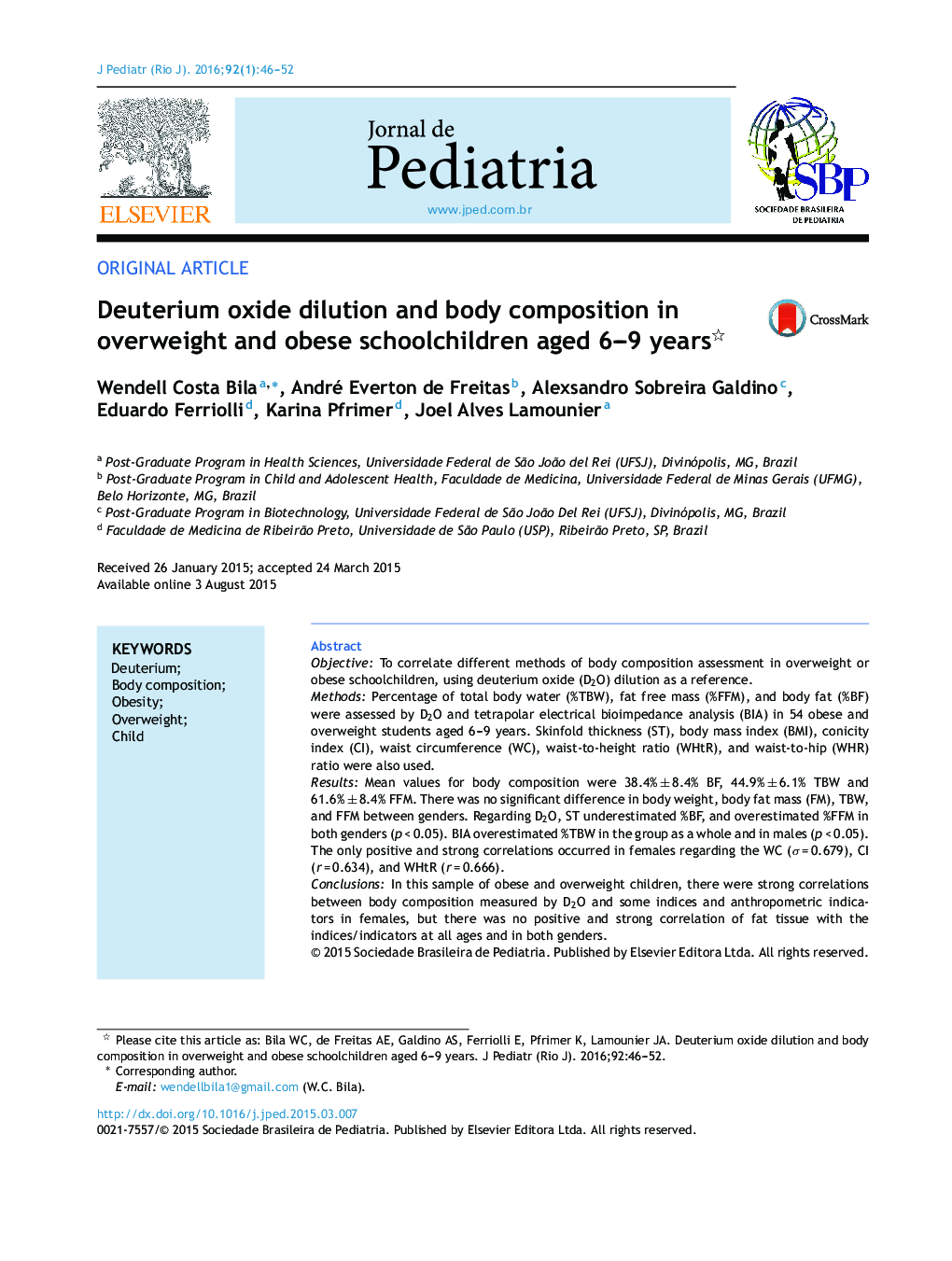| کد مقاله | کد نشریه | سال انتشار | مقاله انگلیسی | نسخه تمام متن |
|---|---|---|---|---|
| 4153882 | 1273680 | 2016 | 7 صفحه PDF | دانلود رایگان |
ObjectiveTo correlate different methods of body composition assessment in overweight or obese schoolchildren, using deuterium oxide (D2O) dilution as a reference.MethodsPercentage of total body water (%TBW), fat free mass (%FFM), and body fat (%BF) were assessed by D2O and tetrapolar electrical bioimpedance analysis (BIA) in 54 obese and overweight students aged 6–9 years. Skinfold thickness (ST), body mass index (BMI), conicity index (CI), waist circumference (WC), waist-to-height ratio (WHtR), and waist-to-hip (WHR) ratio were also used.ResultsMean values for body composition were 38.4% ± 8.4% BF, 44.9% ± 6.1% TBW and 61.6% ± 8.4% FFM. There was no significant difference in body weight, body fat mass (FM), TBW, and FFM between genders. Regarding D2O, ST underestimated %BF, and overestimated %FFM in both genders (p < 0.05). BIA overestimated %TBW in the group as a whole and in males (p < 0.05). The only positive and strong correlations occurred in females regarding the WC (σ = 0.679), CI (r = 0.634), and WHtR (r = 0.666).ConclusionsIn this sample of obese and overweight children, there were strong correlations between body composition measured by D2O and some indices and anthropometric indicators in females, but there was no positive and strong correlation of fat tissue with the indices/indicators at all ages and in both genders.
ResumoObjetivoCorrelacionar diferentes métodos para avaliação de composição corporal em escolares diagnosticados com sobrepeso e obesos, utilizando-se como referência a diluição de óxido de deutério (D2O).MétodosO percentual de água corporal total (%ACT), massa livre de gordura (%MLG) e gordura corporal (%GC) foram obtidos pelo D2O e bioimpedância elétrica tetrapolar (BIA), em 54 estudantes com sobrepeso e obesos, com idade entre 6-9 anos. O método das dobras cutâneas (DC) utilizando-se triciptal e panturrilha, índice de massa corporal (IMC), índice de conicidade (IC), circunferência de cintura (CC), relação cintura/estatura (RCE) e relação cintura/quadril (RCQ) também foram utilizados.ResultadosOs valores médios para composição corporal aferidos pelo D2O foram 38,4 ± 8,4%GC, 44,9 ± 6,1%ACT e 61,6 ± 8,4%MLG. Não houve diferença significativa entre o peso corporal, massa corporal de gordura (MG), ACT e MLG entre os sexos. Considerando o D2O, DC subestimou o %GC e superestimou o %MLG em ambos os sexos (p < 0,05). BIA superestimou %ACT no grupo como um todo e no masculino (p < 0,05). As únicas correlações fortes e positivas ocorreram no grupo feminino nas variáveis CC (σ=0,679), IC (r = 0,634) e RCE (r = 0,666).ConclusõesNesta amostra de crianças obesas e com sobrepeso, houve fortes correlações entre a composição corporal mensurada pelo D2O e alguns índices e indicadores antropométricos nas meninas, mas nenhuma correlação forte e positiva do tecido adiposo foi encontrada com os índices/indicadores em todas as idades e ambos os sexos.
Journal: Jornal de Pediatria - Volume 92, Issue 1, January–February 2016, Pages 46–52
